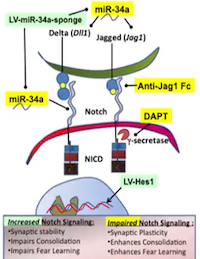
A microRNA that tunes Notch signaling, critical during embryonic development, appears to have a role in fear memory formation.
Nature is thrifty. The same signals that embryonic cells use to decide whether to become nerves, skin or bone come into play again when adult animals are learning whether to become afraid.
Researchers at Yerkes National Primate Research Center, Emory University, have learned that the molecule Notch, critical in many processes during embryonic development, is also involved in fear memory formation. Understanding fear memory formation is critical to developing more effective treatments and preventions for anxiety disorders such as post-traumatic stress disorder (PTSD).
The results were published online Thursday, August 7 by the journal Neuron.
"We are finding that developmental pathways that appear to be quiescent during adulthood are transiently reactivated to allow new memory formation to occur," says Kerry Ressler, MD, PhD, professor of psychiatry and behavioral sciences at Emory University School of Medicine and Yerkes National Primate Research Center, and senior author of the paper.
The first author of the paper is postdoctoral fellow Brian Dias, PhD, and co-authors include undergraduates Jared Goodman, Ranbir Ahluwalia and Audrey Easton, and post-doctoral researcher Raul Andero, PhD.
The Notch signaling pathway, present in insects, worms and vertebrates, is involved in embryonic patterning as well as nervous system and cardiovascular development. It's a way for cells to communicate and coordinate which cells are going to become what types of tissues.
Dias and Ressler probed the Notch pathway because they were examining many genes that are activated in the brains of mice after they learn to become afraid of a sound paired with a mild foot-shock. They were looking for changes in the amygdala, a region of the brain known to regulate fear learning.
The researchers were particularly interested in micro RNAs. MicroRNAs do not encode proteins but can inhibit other genes, often several at once in a coordinated way. Dias and Ressler found that levels of miRNA-34a are increased in the amygdala after fear learning occurs. A day after fear training, animals whose brains were injected with a virus engineered to carry a "sponge" against miRNA-34a froze less often than control animals.
The researchers found that miRNA-34a regulated several genes that encode components of the Notch pathway. They believe their study is the first to link miRNA-34a and Notch signaling to a role in memory consolidation.
Notch is under investigation as a target in the treatment of various cancers and some drugs that target Notch have been well-tolerated by humans.
“From a therapeutic perspective, our data suggest that relevant drugs that regulate Notch signaling could potentially be a starting point for preventing or treating PTSD,” Dias says.
The research was supported by the National Institutes of Mental Health (1R21MH101492-01, 1R01MH096764), National Institute for Neurological Disorders and Stroke Core Facilities grant (P30NS055077), the Office of Research Infrastructure Programs (Primate centers: P51OD11132 – formerly NCRR P51RR000165) and the Burroughs Wellcome Fund. Ressler is a Howard Hughes Medical Investigator.
